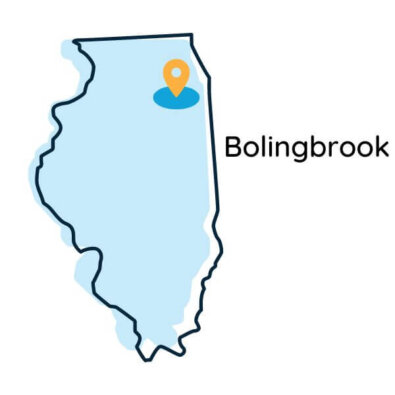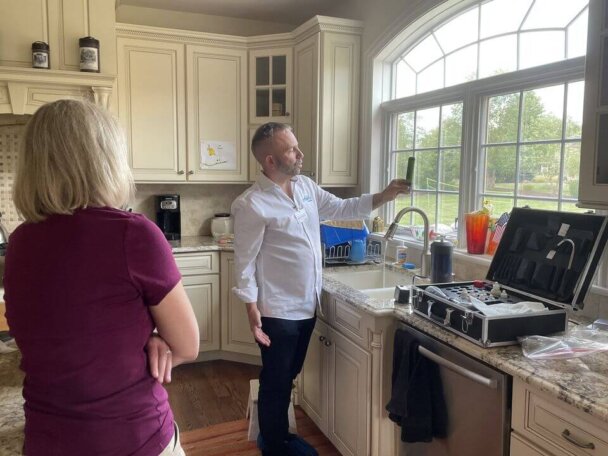Struggling with hard water in Bolingbrook, IL? Angel Water understands the specific water challenges faced by residents here. Our high-quality water softening systems are designed to eliminate excess calcium and magnesium, providing soft, clean water for your home or business. With over 50 years of experience in the water treatment industry, we are dedicated to enhancing your water quality and ensuring your complete satisfaction.
Water Softener in Bolingbrook, IL
How Do I Choose the Right Water Softener and Get Started?
The process begins with a water test to identify contaminants. Understanding these issues helps us develop a solution. We then conduct a plumbing inspection to determine the best installation spot. Finally, we determine the type and size of the necessary equipment.
Thinking, “Can’t you just tell me over the phone? You installed my neighbor’s system!” We understand – we’re consumers too. However, your neighbor’s water or plumbing might differ slightly. Our goal is to ensure you have perfect water for drinking and bathing. We provide unbiased third-party water testing and employ licensed plumbers as required by Illinois law, prioritizing your family’s health and well-being.
Why Choose Angel Water?
Expertise:
Over 50 years of experience in resolving water quality issues.
Advanced Technology:
Our water softeners use the latest technology for efficient operation.
Customer Satisfaction:
Free water analysis and customized solutions tailored to your needs.
Qualified Professionals:
IDPH Licensed Plumbers in Illinois ensure high-quality service and regulatory compliance.
Highly Rated:
Over 1,000 5-star ratings on Google demonstrate our commitment to excellent service.
Licensed Plumbing Company:
The only water softening company in Illinois that is also a licensed plumbing company.
Lifetime Warranty:
The only company offering a lifetime warranty on our ERR-3700 series filters.
A+ BBB Rating:
An A+ rating with the Better Business Bureau shows our commitment to quality service.
Benefits of Water Softening
Prevent Scale Buildup:
Soft water helps prevent scale buildup in pipes and appliances, extending their lifespan.
Better Cleaning:
Enjoy cleaner dishes, softer laundry, and easier cleaning.
Improved Skin and Hair:
Soft water is gentle on skin and hair, reducing dryness and irritation.

Discover How to Improve Your Family’s Water
Is Bolingbrook’s water safe to drink? Water departments in Chicagoland have shown that there are several contaminants in Bolingbrook’s water. While these contaminants are below federal limits, these limits are 20 years old, so legal amounts can still be harmful to the human body.
Don’t settle for carcinogenic water that makes you sick. Keep reading to learn:
- The history of Bolingbrook’s water
- Which contaminants tests have revealed
- Steps you can take to stay healthy
- How Angel Water can provide clean water
Where Does Bolingbrook Get Its Water?
Until 2001, Bolingbrook received its water from wells. For the last 20 years, its water has come from Lake Michigan. A subsidiary of the Illinois American Water Company, the American Lake Water Company processes incoming water.
Switching to a private company for water treatment has elevated water bills across town, and treatment may not remove all pollutants. Bolingbrook’s water quality has improved over the years, but it’s not pristine.
Water treatment isn’t sterilization. To treat water, a treatment plant adds “clean” chlorine instead of removing “dirty” contaminants, so they will still find a way to your faucet. Furthermore, chlorine isn’t good to ingest or touch either.
Does Bolingbrook Have Hard Water?
Preventing contamination is key for protecting yourself from illness, but a water’s hardness may also present problems. How can water be hard? Well, it isn’t. The sediment inside it is, and the number of calcium particles inside a water sample informs that sample’s hardness. Across the United States, tap water is pretty “hard,” especially in Illinois and Florida.
At 108 mg/L, the hardness of Bolingbrook’s water is moderate. There are 6.4 grains of sediment per gallon. The inconveniences hardness causes include everything from cloudy spots on glasses to broken dishwashers.
While there are many more problems inherent to hard water, we can help you install certified devices that “soften” water, removing sediment and alleviating the effects of sediment on pipes and appliances.
What’s in Bolingbrook’s drinking water?
According to the Environmental Protection Agency’s (EPA) standards, Bolingbrook water’s contaminants are at drinking-safe levels, but these standards are decades old. The Environmental Working Group (EWG) presents much more stringent standards in the interest of public health. According to the EWG, any amount of contamination is dangerous, so it also highlights the very presence of pollutants that remain under their respective thresholds.
The following chart displays contaminants that exceeded safe levels in Bolingbrook from 2013 to 2019:
| CONTAMINANT | TOTAL |
EWG RECOMMENDED
|
| Chromium (Hexavalent) | 0.203 ppb | 0.02 ppb |
| Haloacetic Acids (HAA9) | 25.3 ppb | 0.06 ppb |
| Total Trihalomethanes (TTHMs) | 32.8 ppb | 0.15 ppb |
What problems do these four pollutants cause? Let us show you.
Chromium (Hexavalent)
To be blunt, this is the pollutant from Erin Brockovich with Julia Roberts. Remember how all those poor people were coughing their heads off? Excess chromium-6 in drinking water will give you a lot more than dry skin, causing lung cancer among other respiratory ailments. A common industrial pollutant, chromium-6 has been uncovered by the EPA and EWG all over Chicagoland. Again, legally speaking, it’s “safe.”
Haloacetic Acids (HAA9)
These acids are disinfectant byproducts that form as a result of chlorine-based water treatment. They can dry out your skin and even cause cancer. According to the government, treating water with chemicals is better than letting it go straight from the lake to your mouth. As important as treating water is for consumption and contact, we’re here to help you with other necessary steps.
These individual members of the haloacetic acids also exceeded EWG health guidelines in Bolingbrook:
- Dibromoacetic Acid
- Dichloroacetic Acid
- Trichloroacetic Acid
Significant amounts of monobromoacetic acid and monochloroacetic acid were also detected in Bolingbrook water. However, neither of those contaminants exceeded the EWG’s guidelines.
Total Trihalomethanes (TTHMs)
These are further byproducts of water treatment. For all chemicals of this type, bromodichloromethane maintains the highest saturation at nearly 200 times the EWG’s recommended limit. These products are as carcinogenic as haloacetic acids.
These individual TTHMs also exceeded EWG health guidelines in Bolingbrook:
- Bromodichloromethane
- Chloroform
- Dibromochloromethane
Bromoform was also detected in the water but not at a level exceeding the EWG limit.
Other Contaminants
Apart from contaminants above the EWG’s limits, there are other contaminants present in Bolingbrook’s water, including:
- Chlorate
- Chromium (Total)
- Manganese
- Molybdenum
- Strontium
- Vanadium
While these contaminants don’t exceed limits, the EWG suggests that their mere presence is problematic. You can learn more about all of them on the EWG’s Bolingbrook page.
How Can Bolingbrook Residents Protect Their Health?
There’s no single solution to every home’s water problem. In fact, many water optimization products contradict each other. Some systems inject chlorine, while others remove it. You’ll have to adjust in either direction depending on what’s in your water.
The best way to discern the source of your water’s contamination is to test it, and we can help you do that. Once we uncover the problem, we can help you find the product that best suits your needs.
Step 1: Test Your Water
Testing your water is also virtually the only way to confirm what’s in it. An EPA-certified water test reveals the presence of contaminants as well as the hardness of your water. If you complete the test with us, we can help you make your next move based on the results
Step 2: Consider an NSF/ANSI 58 Certified Reverse Osmosis System
If your test reveals the presence of contaminants, reverse osmosis (RO) systems address most of them. Until you test your water, we can’t recommend this device one way or the other, but it’ll likely be the one you need.
RO systems can remove:
- Chromium (Hexavalent)
- Chromium (Total)
- Germanium
- Molybdenum
- Haloacetic Acids
- Strontium
- Total Trihalomethanes
RO systems work by filtering water through a semipermeable membrane that catches the above contaminants. In fact, this membrane is so effective as to yield “dead water,” or water that contains no invasive matter, but RO systems compensate for this by injecting calcium and magnesium into the water. The best RO systems are NSF/ANSI 58 certified, which means that rigorous inspections have put them through multiple tests to make sure they’ll do their job perfectly.
Step 3: Consider an NSF/ANSI 44 Certified Water Softener
If your test obviates the presence of hard water, a salt-based water softener will be the best solution. A salt-based system uses ion exchange to remove particles from the water before it goes to your home. You will have to buy and carry large bags of salt to maintain your device, but the only alternative is to use a salt-free system. Salt-free systems don’t actually soften the water. They only condition the water to keep sediment from sticking to pipes.
We encourage you to install EcoWater softeners. Ecowater’s salt-based water softeners are NSF/ANSI 44 certified, so not only will they soften your water, but they’ll keep certain contaminants out as well. You can also monitor EcoWater’s devices from your smartphone as they work.
Step 4: Have Us Professionally Install and Maintain Your System
Professional installations allow for longevity and utility. Our plumbers have licenses to install and maintain water systems. Whichever one you need, many manufacturers require annual maintenance for you to keep your warranty, so be sure to have your system professionally installed and maintained.
We’re Here to Help Bolingbrook Residents
Hopefully, this post has taught you a thing or two about the importance of clean water. There’s no need to settle for cancer-causing agents in the water you drink. We can help you test your water and find the right product for healthier and tastier water in your home.
We’ve been educating families across Chicagoland for more than 50 years, so our licensed plumbers would be happy to help you find the right RO system or water softener. We’re available for testing, installation and maintenance.
Please call us today at (847) 382-7800
or fill out the form below to talk with an expert or schedule a free consultation!
How do I know what system is right for my family?
Get Started With A Free Water Test!
Just fill out the form below and we will reach out to schedule the best time for your free water test!
Would You Like to Know More About Water Quality in Bolingbrook?
If you want to understand the quality of the water your family depends on everyday, contact us today. One of our representatives is standing by to help you schedule your free water test. We’ll send one of our local water expert to test the water at your tap and explain common problems and solutions for your specific water composition so that you can rest easy, knowing that your family is drinking the healthiest water possible.

